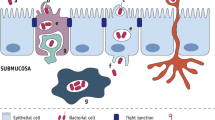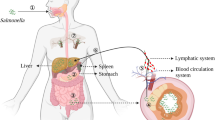Abstract
As an indispensable virulence determinant, Salmonella pathogenicity island 1(SPI-1) has gained much attention in host–pathogen interactions. More and more studies on SPI-1 have demonstrated that it is far more complex than the one we used to expect. It not only affects sophisticated activities during infection, including invasion, replication, and host responses, but also extends to other fields like biofilm formation. In addition, mutants in SPI-1 effectors have been explored as vaccines, the effective ways to prevent salmonellosis. The activity of SPI-1 is influenced by many factors which have been widely reported. Investigations on these factors may provide new insights into prevention and treatment of salmonellosis. Therefore, SPI-1 is a tempting issue worthy of further exploration. In this review, we will probe into SPI-1 systematically.
Similar content being viewed by others
References
Bueno SM, Wozniak A, Leiva ED et al (2010) Salmonella pathogenicity island 1 differentially modulates bacterial entry to dendritic and non-phagocytic cells. Immunology 130(2):273–287
Bakowski MA, Braun V, Lam GY et al (2010) The phosphoinositide phosphatase SopB manipulates membrane surface charge and trafficking of the Salmonella-containing vacuole. Cell Host Microbe 7(6):453–462
Brandl MT, Carter MQ, Parker CT, Chapman MR, Huynh S, Zhou Y (2011) Salmonella biofilm formation on Aspergillus niger involves cellulose—chitin interactions. PLoS ONE 6(10):e25553
Bohez L, Ducatelle R, Pasmans F, Haesebrouck F, Van Immerseel F (2007) Long-term colonisation-inhibition studies to protect broilers against colonisation with Salmonella Enteritidis, using Salmonella pathogenicity island 1 and 2 mutants. Vaccine 25(21):4235–4243
Bulmer DM, Kharraz L, Grant AJ et al (2012) The bacterial cytoskeleton modulates motility, type 3 secretion, and colonization in Salmonella. PLoS Pathog 8(1):e1002500
Clark L, Perrett CA, Malt L et al (2011) Differences in Salmonella enterica serovar Typhimurium strain invasiveness are associated with heterogeneity in SPI-1 gene expression. Microbiology 157:2072–2083
Crull K, Rohde M, Westphal K et al (2011) Biofilm formation by Salmonella enterica serovar Typhimurium colonizing solid tumours. Cell Microbiol 13(8):1223–1233
Chen ZW, Hsuan SL, Liao JW et al (2009) Mutations in the Salmonella enterica serovar Choleraesuis cAMP-receptor protein gene lead to functional defects in the SPI-1 Type III secretion system. Vet Res 41(1):05
Cameron AD, Dorman CJ (2012) A fundamental regulatory mechanism operating through OmpR and DNA topology controls expression of Salmonella pathogenicity islands SPI-1 and SPI-2. PLoS Genet 8(3):e1002615
Desin TS, Mickael CS, Lam PK, Potter AA, Köster W (2010) Protection of epithelial cells from Salmonella enterica serovar Enteritidis invasion by antibodies against the SPI-1 type III secretion system. Can J Microbiol 56(6):522–526
Desin TS, Wisner AL, Lam PK et al (2011) Evaluation of Salmonella enterica serovar Enteritidis pathogenicity island-1 proteins as vaccine candidates against S. Enteritidis challenge in chickens. Vet Microbiol 148(2–4):298–307
Fink SL, Cookson BT (2007) Pyroptosis and host cell death responses during Salmonella infection. Cell Microbiol 9(11):2562–257013
Feng Y, Hsiao YH, Chen HL, Chu C, Tang P, Chiu CH (2009) Apoptosis-like cell death induced by Salmonella in Acanthamoeba rhysodes. Genomics 94(2):132–137
Gong H, Vu GP, Bai Y et al (2011) A Salmonella small non-coding RNA facilitates bacterial invasion and intracellular replication by modulating the expression of virulence factors. PLoS Pathog 7(9):e1002120
Humphreys D, Hume PJ, Koronakis V (2009) The Salmonella effector SptP dephosphorylates host AAA+ ATPase VCP to promote development of its intracellular replicative niche. Cell Host Microbe 5(3):225–233
Hung C–C, Haines L, Altier C (2012) The flagellar regulator fliT represses Salmonella pathogenicity island 1 through flhDC and fliZ. PLoS ONE 7(3):e34220
Ibarra JA, Knodler LA, Sturdevant DE et al (2010) Induction of Salmonella pathogenicity island 1 under different growth conditions can affect Salmonella–host cell interactions in vitro. Microbiolog 156(Pt 4):1120–1133
Jennings ME, Quick LN, Ubol N, Shrom S, Dollahon N, Wilson JW (2012) Characterization of Salmonella type III secretion hyper-activity which results in biofilm-like cell aggregation. PLoS ONE 7(3):e33080
Juárez-Rodríguez MD, Arteaga-Cortés LT, Kader R, Curtiss R 3rd, Clark-Curtiss JE (2012) Live attenuated Salmonella vaccines against Mycobacterium tuberculosis with antigen delivery via the type III secretion system. Infect Immun 80(2):798–814
Kim K, Yang E, Vu GP et al (2010) Mass spectrometry-based quantitative proteomic analysis of Salmonella enterica serovar Enteritidis protein expression upon exposure to hydrogen peroxide. BMC Microbiol 10:166
Knodler LA, Finlay BB, Steele-Mortimer O (2005) The Salmonella effector protein SopB protects epithelial cells from apoptosis by sustained activation of Akt. J Biol Chem 280(10):9058–9064
Kum WW, Lo BC, Yu HB, Finlay BB (2011) Protective role of Akt2 in Salmonella enterica serovar Typhimurium-induced gastroenterocolitis. Infect Immun 79(7):2554–2566
Kage H, Takaya A, Ohya M, Yamamoto T (2008) Coordinated regulation of expression of Salmonella pathogenicity island 1 and flagellar type III secretion systems by ATP-dependent ClpXP protease. J Bacteriol 190(7):2470–2478
Kint G, De Coster D, Marchal K, Vanderleyden J, De Keersmaecker SC (2010) The small regulatory RNA molecule MicA is involved in Salmonella enterica serovar Typhimurium biofilm formation. BMC Microbiol 10:276
Kim Y, Mylonakis E (2011) Killing of Candida albicans filaments by Salmonella enterica serovar Typhimurium is mediated by sopB effectors, parts of a type III secretion system. Eukaryot Cell 10(6):782–790
Lara-Tejero M, Galán JE (2009) Salmonella enterica serovar Typhimurium pathogenicity island 1-encoded type III secretion system translocases mediate intimate attachment to nonphagocytic cells†. Infect Immun 77(7):2635–2642
Lu R, Wu SP, Liu XY, Xia YL, Zhang YG, Sun J (2010) Chronic effects of a Salmonella type III secretion effector protein AvrA in vivo. PLoS ONE 5(5):e10505
Lamprokostopoulou A, Monteiro C, Rhen M, Römling U (2010) Cyclic di-GMP signalling controls virulence properties of Salmonella enterica serovar Typhimurium at the mucosal lining. Environ Microbiol 12(1):40–53
López-Garrido J, Casadesús J (2012) Crosstalk between virulence loci: regulation of Salmonella enterica pathogenicity island 1 (SPI-1) by products of the std fimbrial operon. PLoS ONE 7(1):e30499
Misselwitz B, Kreibich SK, Rout S, Stecher B, Periaswamy B, Hardt WD (2010) Salmonella enterica serovar Typhimurium binds to HeLa cells via fim-mediated reversible adhesion and irreversible type three secretion system 1-mediated docking. Infect Immun 79(1):330–341
Mallo GV, Espina M, Smith AC et al (2008) SopB promotes phosphatidylinositol 3-phosphate formation on Salmonella vacuoles by recruiting Rab5 and Vps34. J Cell Biol 182(4):741–752
Müller AJ, Hoffmann C, Galle M et al (2009) The S. Typhimurium effector SopE induces caspase-1 activation in stromal cells to initiate gut inflammation. Cell Host Microbe 6(2):125–136
Matulova M, Havlickova H, Sisak F, Rychlik I (2012) Vaccination of chickens with Salmonella pathogenicity island (SPI) 1 and SPI2 defective mutants of Salmonella enterica serovar Enteritidis. Vaccine 30(12):2090–2097
Martínez LC, Yakhnin H, Camacho MI et al (2011) Integration of a complex regulatory cascade involving the SirA/BarA and Csr global regulatory systems that controls expression of the Salmonella SPI-1 and SPI-2 virulence regulons through HilD. Mol Microbiol 80(6):1637–1656
Pavlova B, Volf J, Ondrackova P et al (2011) SPI-1-encoded type III secretion system of Salmonella enterica is required for the suppression of porcine alveolar macrophage cytokine expression. Vet Res 42(1):16
Patel JC, Hueffer K, Lam TT, Galán JE (2009) Diversification of a Salmonella virulence effector protein function by ubiquitin-dependent differential localization. Cell 137(2):283–294
Papezova K, Havlickova H, Sisak F, Kummer V, Faldyna M, Rychlik I (2008) Comparison of live and inactivated Salmonella Typhimurium vaccines containing different combinations of SPI-1 and SPI-2 antigens in poultry. Vet Med Czech 53(6):315–323
Rosales-Reyes R, Pérez-López A, Sánchez-Gómezd C et al (2012) Salmonella infects B cells by macropinocytosis and formation of spacious phagosomes but does not induce pyroptosis in favor of its survival. Microb Pathoq 52(6):367–374
Radtke AL, Wilson JW, Sarker S, Nickerson CA (2010) Analysis of interactions of Salmonella type three secretion mutants with 3-D intestinal epithelial cells. PLoS ONE 5(12):e15750
Rosenzweig JA, Chopra AK (2012) The future of plague vaccines: hopes raised by a surrogate, live-attenuated recombinant vaccine candidate. Expert Rev Vaccines 11(6):659–661
Silva-Herzog E, Detweiler CS (2010) Salmonella enterica replication in hemophagocytic macrophages requires two type three secretion systems. Infect Immun 78(8):3369–3377
Shirron N, Yaron S (2011) Active suppression of early immune response in tobacco by the human pathogen Salmonella Typhimurium. PLoS ONE 6(4):e18855
Schikora A, Virlogeux-Payant I, Bueso E, Garcia AV, Nilau T et al (2011) Conservation of Salmonella infection mechanisms in plants and animals. PLoS ONE 6(9):e24112
Takaya A, Suzuki A, Kikuchi Y et al (2005) Derepression of Salmonella pathogenicity island 1 genes within macrophages leads to rapid apoptosis via caspase-1- and caspase-3-dependent pathways. Cell Microbiol 7(1):79–90
Webber MA, Bailey AM, Blair JM et al (2009) The global consequence of disruption of the AcrAB-TolC efflux pump in Salmonella enterica includes reduced expression of SPI-1 and other attributes required to infect the host. J Bacteriol 191(13):4276–4285
Author information
Authors and Affiliations
Corresponding author
Additional information
Supported by Natural Science Foundation of Jiangsu province (No. BK2011286).
Rights and permissions
About this article
Cite this article
Que, F., Wu, S. & Huang, R. Salmonella Pathogenicity Island 1(SPI-1) at Work. Curr Microbiol 66, 582–587 (2013). https://doi.org/10.1007/s00284-013-0307-8
Received:
Accepted:
Published:
Issue Date:
DOI: https://doi.org/10.1007/s00284-013-0307-8




